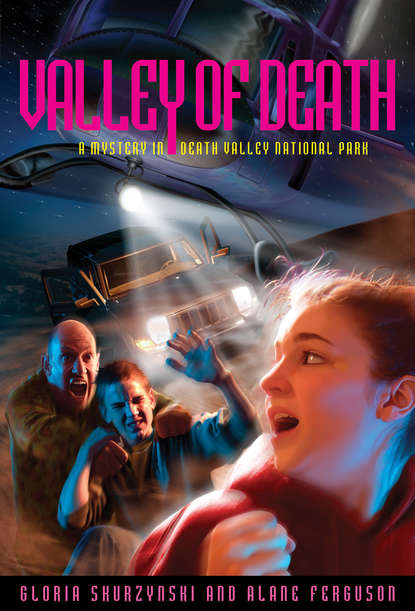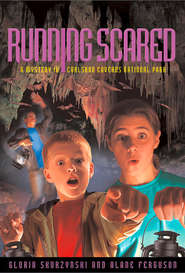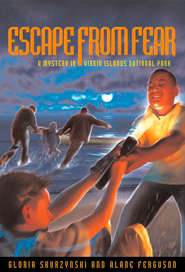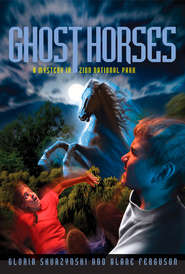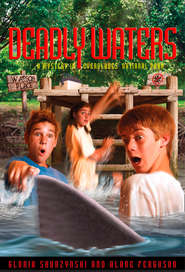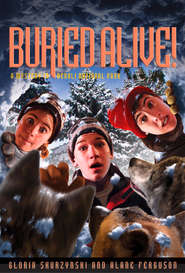По всем вопросам обращайтесь на: info@litportal.ru
(©) 2003-2024.
✖
Mysteries in Our National Parks: Valley of Death: A Mystery in Death Valley National Park
Настройки чтения
Размер шрифта
Высота строк
Поля
“OK, guys, we better go,” Olivia urged. “There’s a restaurant up ahead a little way, but if no one’s too hungry, I think we ought to keep going and see Ashley’s ghost town first, then we can eat on the way back. That way, if we’re running late, we’ll just pick up a pizza and take it with us.”
Since they’d finished breakfast not much more than two hours earlier, everyone agreed to that plan. The drive was already turning out to be longer than they’d expected, and after another half hour Ashley yelled, “Stop the car!”
“Why? Are we at Skidoo?” Jack wanted to know.
“No, not yet, but Dad—you gotta get a picture of those rocks. Do you see them? They look like ghost heads,” Ashley declared. “Like a whole lot of skulls lined up in a haunted house.”
Squinting a little, Jack guessed he could see what she was talking about: A thick, dark, craggy layer of rock rested on an almost white layer at the top of a high cliff. The dark rock had eroded into shapes that Ashley, with her big imagination, saw as skulls, probably because shallow caves in the cliff face looked like empty eye sockets above screaming mouths. It would make a great place for a Halloween party.
“Death, death, everywhere you look,” Leesa murmured. “This place is depressing.”
Since Steven’s camera was still on the front seat where he’d put it after photographing the dunes, he picked it up to focus on the ghost heads. Not too far behind them, a person on a motorcycle stopped along the side of the road, probably figuring there must be something worth photographing. That’s what happened all the time in the national parks: Someone stopped to take a picture, and it quickly started a chain reaction, every following driver slowing down or stopping to see what was happening. At Yellowstone, if a bear or a moose ambled across a field, traffic could get backed up for a quarter mile.
In a few minutes Steven had taken the pictures Ashley wanted, and they were on their way again. Jack noticed the motorcyclist following, keeping a good distance behind them. He couldn’t tell whether it was a man or a woman. Leesa kept turning around to glance at the motorcyclist. Jack wondered why she seemed so interested, but he didn’t ask. Maybe she just liked motorcycles.
The drive seemed to go on and on, or maybe it just felt longer because Olivia kept looking at her watch. “According to the map,” Jack said, “we ought to be getting close to the turnoff for Skidoo. And there’s the sign. Turn left, Dad.”
The first hundred yards or so of the dirt road were fairly smooth, but then it turned into a washboard that rattled their teeth. “I hope it’s going to be worth it,” Ashley said, her voice quavering from the jouncing. “I mean, it’s my fault that we’re coming way up here on the top of the mountain. The ranger told me it was a special place to visit, but I—I hope—“
“Don’t worry about it, sweetie,” Steven told her. “I’m looking forward to it because I’ve never photographed a ghost town before. Hey, maybe I can get a picture of a real ghost.”
“Then you could sell it to the National Enquirer,” Jack answered. “It would rate the front page.”
Since the vehicle’s jouncing made their voices jiggle, no one said much more until they rounded a curve in the road and came upon the ruins of the ghost town—although the only ruins they could see were old mine structures, with their walls collapsed and their boards faded or fallen down on the slopes. No houses, no stores, no sign at all of the thousands of people who’d once staked their lives and fortunes on hopes of striking gold in these mountains.
“This is it?” Jack asked. He wondered why they’d bothered coming here. There wasn’t much to see. He started to walk along the pebbly, sandy, barren surface, and accidentally kicked a rusty tin can. When he reached the place a few yards ahead where the can had landed, he stopped to pick it up.
It was bent in the middle, squeezed into an uneven oval shape—the dusty inside coated with a residue of sand, the outside mottled with colors from copper to rust to the hue of dried blood. As Jack held the dented old can in his hand, scenes began to take shape in his mind. Some old miner must have opened this long ago—maybe a hundred years ago—to eat the beans inside. With pick and shovel, the man had dug inside the earth, hoping his miner’s lamp would catch a flash of gold in the rock that surrounded him. Sweating, cursing the heat, drinking lukewarm water from a bucket, he’d have swung that pick again and again, waiting for good fortune to shower down on him. At the end of long hours of digging, he’d have gone home to a shack or a tent and opened a can of beans for his supper. This can.
“Can I have that?” Ashley asked. “If I tell you a story about Skidoo, and about the ghost that lives here, will you give me the can?”
“No, you can’t have it,” he told her. “It’s like anything else in a national park—you leave things where you find them. I’m putting it back.”
Leesa, who’d overheard them, said, “You know a story about this place, Ashley? I’d like to hear it.”
By tradition, Ashley was the family storyteller. Before they visited each national park, she’d check out library books to learn all she could about the place. Once they reached the park, she would talk to park rangers, asking questions. They always seemed glad to share stories about park history or about their own personal experiences, like the ranger in Glacier National Park who’d told about her terrifying encounter with a grizzly bear.
Вы ознакомились с фрагментом книги.
Приобретайте полный текст книги у нашего партнера:
Приобретайте полный текст книги у нашего партнера:





